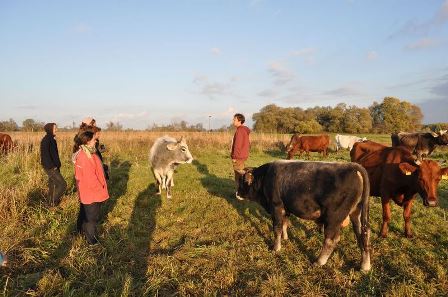Resisting Land Grabbing in Germany

Land grabbing is no longer a phenomenon of the Global South only. In rural Germany, a highly undemocratic form of land control is accelerating the process of land concentration, contributing to the increase of land prices and creating barriers for young farmers to enter agriculture. With the Voluntary Guidelines on the Responsible Governance of Tenure of Land, Fisheries and Forests at hand, young farmers in Germany are trying to reverse this situation and claim agricultural land.
Until 2016, KTG-Agrar was the biggest agribusiness land owner in Germany, controlling over 38,000 ha in the country. When KTG-Agrar filed for bankruptcy, the young peasant association (Bündnis junge Landwirtschaft, BjL) together with young, mostly landless, members from La Via Campesina’s member organisation in Germany (Arbeitsgemeinschaft bäuerliche Landwirtschaft, AbL) gathered on the fields of KTG-Agrar. We peacefully expressed our desire to establish sustainable agriculture in the area, and we asked for support from the government for this. Nevertheless, the land was sold, via a dubious structure of shareholding companies, to a transnational insurance company from southern Germany and to a private foundation from Lichtenstein (Münchener Rück and Gustav-Zech-Stiftung).
This is an example of what we call land grabbing in our territory. In Germany, increasing land concentration is creating a situation of inequitable access to land. This is driving family farmers out of business and blocks the entrance of aspiring young farmers. In 2010, the largest 7% of the farms controlled 37% of the farm land. This trend is ongoing and is accompanied by an increase in agro-industrial agriculture; it is undermining peasant agriculture, ecological resilience and food sovereignty. Moreover, these changes are eroding culture and social life in rural Germany.
Land grabbing in Europe?
Land grabbing has been described by the European Coordination of La Via Campesina (ECVC) as: the legal or illegal control of ‘larger than locally-typical’ amounts of land by any persons or entities for purposes of speculation, extraction, resource control or commodification at the expense of peasant farmers, agroecology, land stewardship, food sovereignty and human rights. This challenges the notion that Europe is a showcase of good land governance with well-regulated land markets.
Land grabbing, as defined by the ECVC, exists in Europe and is exacerbated by the unequal distribution of subsidies from the European Union. For example, 28.4% of CAP (Common Agriculture Policy) payments in Germany are given to 1.2% of the beneficiaries. Furthermore, factors such as skyrocketing land prices help to explain why the remaining small and medium scale farms are being forced out of agriculture. These farmers, as well as aspiring young peas-ants, simply don’t have the capital to compete with investors – many of which are non-agricultural – to either keep, or access land.
Tenure Guidelines at home
As young peasants, we are trying to turn the tide. Together with allies from civil society organisations, we are making use of the United Nation’s Voluntary Guidelines on the Responsible Governance of Tenure of Land, Fisheries and Forests (VGGT, see box). We are asking the government to implement the VGGTs in our country, and to bring coherence to local and national policy. Currently, the German government supports the implementation of the VGGTs in partner states in the south.
In September 2016, a coalition of German peasants and allied NGOs participated in the first national ex-ercise to monitor the implementation of the VGGTs not only abroad, but also at home. This event was organised by the German Ministry for Economic Cooperation and Development and the Ministry of Food and Agriculture.
The event gathered around 60 participants from the government, development agencies, civil society organisations (CSOs), academia and the private sector. They aimed to highlight achievements, challenges and recommendations for the implementation of the VGGTs based on the past four years of experience with them. Through testimonies and working group discussions we jointly identified some key challenges and next steps.
In the German context, the event highlighted the urgent need to increase awareness about the VGGTs in Germany. CSOs and academics especially, ex-pressed the need for more transparency and higher public participation in land acquisition processes and land use decisions. We recommended the translation of the ‘People’s Manual’, a version of the guidelines in easy-to-understand language, into German, and the development of a legal assessment on the compliance of the German land law with the VGGTs. Jointly we agreed on the need of increased use, application and implementation of the VGGTs by Germany, also at home, and that for this, more policy coherence is needed. Therefore we recommended the creation of a multi-stakeholder process to accompany the implementation of the VGGTs in Germany. This marks the beginning of an important policy reform process.
With this event and the related process, Germany, together with France, were the first European countries to start a monitoring of the implementation of the VGGTs. Besides the fact that an important process has been triggered in Germany, our experience can be useful for actors in other countries dealing with similar land struggles.
By Paula Gioia
Source: Farming Matters | 33.1 | April 2017
Paula Gioia (paula.gioia@eurovia.org) is a beekeeper and small-scale farmer in Eastern Germany. She is a founding member of the Bündnis junge Landwirtschaft, member of the Arbeitsgemeinschaft bäuerliche Landwirtschaft and member of the coordination committee of the European Coordination Via Campesina.
More information on land issues in Europe:
Infographics: The state of land concentration in Europe
Land grabbing, land concentration and people’s struggles in Europe (PDF)
Land grabbing and land concentration in Europe – A research brief (PDF)
People’s Manual on the Guidelines on Governance of Land, Fisheries and Forests (PDF)
